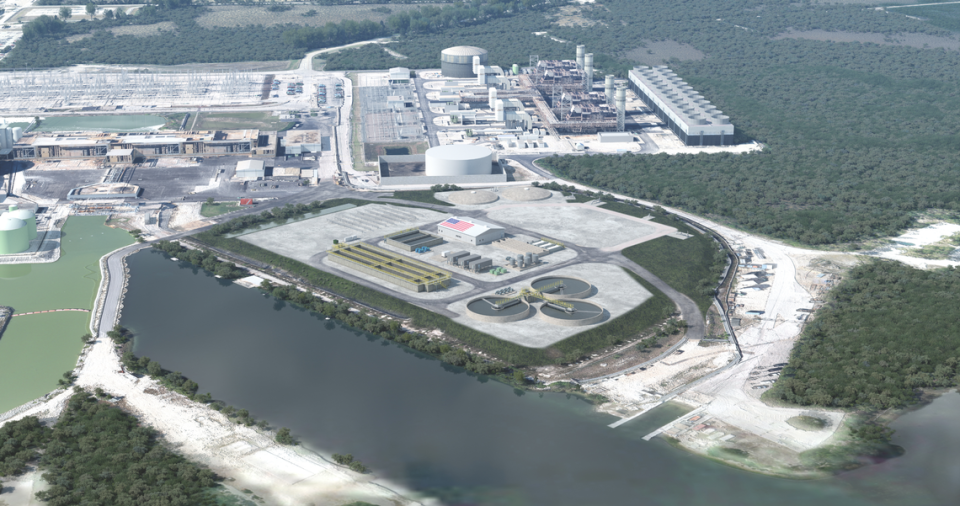What does sewage plant expansion mean for South Miami-Dade? A lot more homes, people
South Dade’s wastewater treatment plant is getting its first serious upgrade in 30 years, a $600 million project that will put the county on the path to halting the practice of piping partially treated sewage into the Atlantic Ocean.
The work also promises a huge impact on the mainland — creating what the county’s water and sewer director called “tremendous development potential” in the southern end of the county.
More capacity at the plant opens the door for more homes and businesses to hook up to the county’s sewage system — without turning to septic tanks, which pose threats to coastal waters and the underground drinking water supply. It all adds up to the potential for a lot more people living in South Miami-Dade.
At a Wednesday morning press conference, Roy Coley, head of Miami-Dade’s Water and Sewer Department, said this project will allow connections supporting 200,000 more residents.
“We expect that this particular expansion will carry us with a very reliable capacity for the next 20 or 30 years,” he said.
Over the next three years, the plant will go from handling 112 million gallons a day to around 130 million gallons. That extra capacity is critical because new development in Miami-Dade is required to connect to county sewer lines if it’s within a certain distance. If the plant didn’t expand, development in the area could potentially slow or even stop. In Miami-Dade, development moratoriums because of outdated or low-capacity wastewater infrastructure aren’t uncommon.
Late last year, property owners in the Ojus neighborhood in north Dade agreed to tax themselves and pay the county to expand wastewater services so they could switch from septic to sewer — and increase the pace of development.
Read More: Miami-Dade is eliminating more dirty septic tanks. And it won’t cost taxpayers a dime
In this case, Coley said, the county realized the problem long before it would have to consider development restrictions. And the expansion — which includes adding things like new “clarifiers,” which sift solids from liquid waste —.ensures it won’t have to.
Besides reducing the impacts of ocean dumping on reefs and coastal waters, the other benefit will be to steer new home development from relying on problematic septic tanks. Miami-Dade has more than 120,000 septic tanks left in the ground, more than any other county in Florida. Many are already old and broken, leaking human waste into canals, rivers and Biscayne Bay. As sea levels rise, thousands more are expected to fail in the combining years.
So far, the county has spent tens of millions helping get rid of the decrepit concrete boxes and connecting homes and businesses to county sewer instead. While the tanks most at risk of leaking are mostly in the northern end of the county, the next biggest cluster of risky tanks is in South Dade.
“These promising plans are a testament to delivering the essential services we couldn’t thrive without,” Miami-Dade Mayor Daniella Levine Cava said Wednesday morning at a groundbreaking event for the project. “We’re ready for the future, come what may.”
Go Deeper: Miami-Dade begins removing polluting septic tanks in race against sea level rise
‘No. 1’ in reuse
At a Wednesday morning press event announcing the expansion, Coley said the project also will make the county a state leader in reusing wastewater.
“That is going to, without question, place Miami Dade County as the largest user of industrial re-use not only in Florida but the entire east coast of the US,” Coley said. “We will be no. 1 in this space.”
While environmentalists have touted using treated wastewater for everyday uses like watering lawns, the county is diverting wastewater backing into the sewage treatment system. The plan is to use treated wastewater, first from the South Dade plant and then eventually at all of the county’s wastewater plants, to cool hot machines that treat and process that wastewater.
If everything goes according to plan, the county would from reusing about 13 million gallons a day to more than 100 million gallons.
Right now, the county uses cooling towers that give off steam to cool its machines. The new plan would use a sealed system that would send the treated wastewater through the machine then inject it 3,000 feet below the ground with all the county’s other treated wastewater.

On top of that, the county recently broke ground on a new project with Florida Power & Light to use another 15 million gallons of wastewater a day to cool its natural gas burning power generator at Turkey Point. The project is expected to be completed by 2024 or 2025.
Together, that would allow Miami-Dade to treat 115 million gallons of wastewater a day, meeting an obligation set by the state more than a decade ago in its ocean outfall legislation. The law is mainly to get counties like Miami-Dade to stop dumping wastewater directly in the ocean, but it also called for counties to reuse at least 60% of its wastewater.
“This will meet our requirements. We’re already in deep analysis of how we can expand it to do even more,” Coley said. “We’re not going to stop.”

